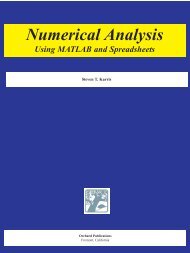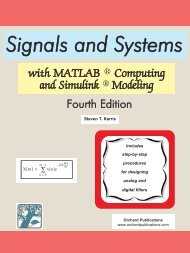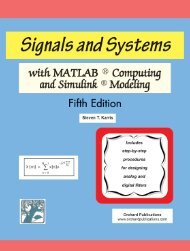COMPUTING
Second Edition - Orchard Publications
Second Edition - Orchard Publications
- No tags were found...
Create successful ePaper yourself
Turn your PDF publications into a flip-book with our unique Google optimized e-Paper software.
Quantization, Quantization Error, Accuracy, and ResolutionI REF = v ref ⁄ R . The voltage v intat the output of the integrator decreases linearly during time T 2as shown in Figure 5.91(b) and when this voltage reaches zero volts, the comparator initiates a signalto stop the binary counter.Let n 1 be the counter reading at the end of T 1 and n 2 be the counter reading at the end of T 2 .Since v max ⁄ T 1 = v in ⁄ ( RC), v max ⁄ T 2 = v ref ⁄ ( RC), and n 1 ⁄ T 1 = n 2 ⁄ T 2 , it follows that⎛ v in ⎞n 2 = n 1 ⎜--------⎟⎝v ref ⎠(5.73)and this expression indicates that the content of the counter at the end of the conversion procedureis directly proportional to the voltage to be digitized. The major advantage of the dual−v inslope architecture ADC over the single−slope architecture ADC is that the entire cycle of theconversion is insensitive to errors since any error introduced by the components R and C duringtime will be cancelled out during time .T 1 T 265.25 Quantization, Quantization Error, Accuracy, and ResolutionIn the previous section we’ve learned how to convert an analog signal to its digital equivalent. Weassumed that the analog signal is continuous in both time and amplitude. To express this signal toa digital form we must subdivide both time and amplitude (for instance volts) into a number ofequally spaced intervals. The subdivision is referred to as quantization. Figure 5.92 shows how ananalog voltage is quantized in both time and amplitude. The intervals on the time and voltageaxes are equally spaced but need not be the same.v ( mV)4.54.03.52.5v ( mV)1.0t ( μs)01 2 3 4 5( a) ( b)7 8 9 10Figure 5.92. An analog voltage quantized in time and amplitudet ( μs)From Figure 5.92(b) we see that at t = 1 μs , v = 1.0 mv, at t = 2 μs , v = 2.5 mv, and so on.But with the quantization we chose, we do not know intermediate values, for instance, we do notknow what the amplitude of the voltage at t = 1.6 μs . Of course, we could quantize the time axisin smaller intervals but no matter how small the intervals are, there will always be a small numberthat will fall between the time intervals. Subdividing the time axis into a finite number of intervalsis known as sampling.Electronic Devices and Amplifier Circuits with MATLAB Computing, Second EditionCopyright © Orchard Publications5−61







